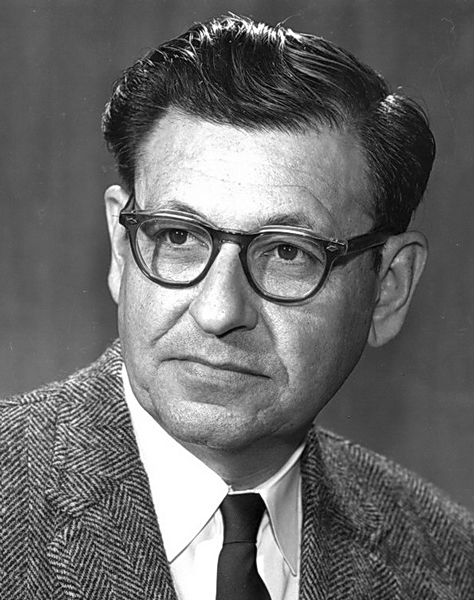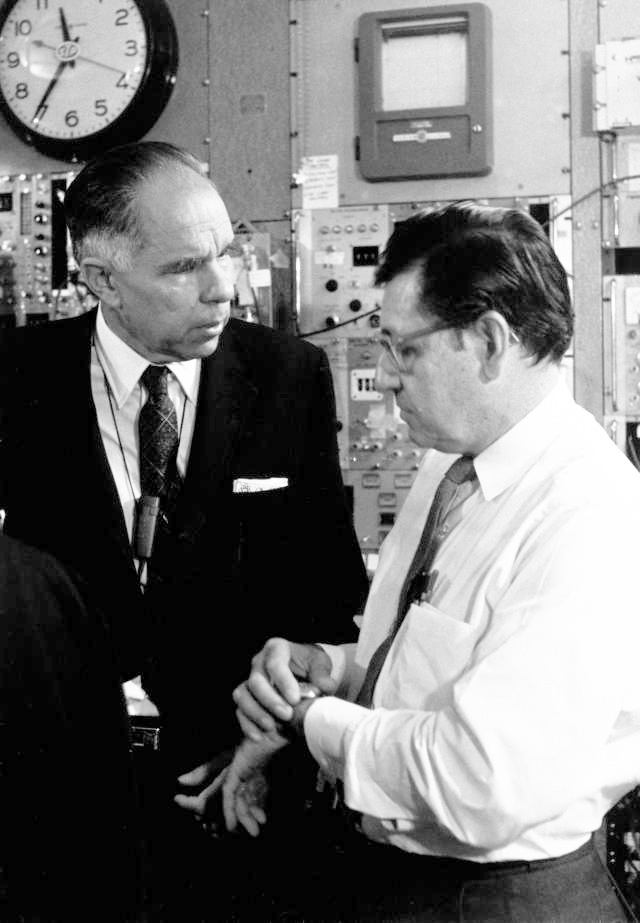This notice of the passing of Berkeley Lab’s unequaled nuclear pioneer Albert Ghiorso was written by his biographer, Dr. Robert W. Schmieder, and appears online, together with a shorter version and links to information about the biography in progress.
BERKELEY, CA—Albert Ghiorso, lifelong nuclear researcher at the Lawrence Berkeley Laboratory, the co-discoverer of twelve chemical elements (more than anyone else in history) and a prolific inventor of nuclear technology, died December 26, 2010, at the age of 95.
Ghiorso was born in Vallejo, California July 15, 1915. He grew up in Alameda, California. As a teenager, he built radio circuitry and earned a reputation for establishing radio contacts at distances that outdid the military. He received his BS in electrical engineering from the University of California, Berkeley in 1937. After graduation, he worked for a company that produced emergency communication devices and invented the world’s first commercial Geiger counter.
Ghiorso’s ability to produce radiation detectors brought him into contact with the scientists at the University of California, in particular Glenn Seaborg. His career in nuclear science began in 1941 when he accepted a position with Seaborg in Chicago to work on the Manhattan Project. Over the next four years Ghiorso developed sensitive instruments for detecting the radiation associated with nuclear decay, including spontaneous fission. One of Ghiorso’s breakthrough instruments was a 48-channel pulse height analyzer, which enabled him to identify the energy, and therefore the source, of the radiation. During that period they discovered two new elements, 95 (Americium) and 96 (Curium).
After the war, Seaborg and Ghiorso returned to Berkeley, where they and colleagues used the 60″ Crocker cyclotron to produce elements of increasing atomic number by bombarding exotic targets with helium ions. In experiments during 1949-1950, they produced and identified elements 97 (Berkelium) and 98 (Californium). In 1953, in a collaboration with Argonne Lab, Ghiorso sought and found elements 99 (Einsteinium) and 100 (Fermium) in dust collected by airplanes from the first thermonuclear explosion (the Mike test). In 1955, the group used the cyclotron to produce 17 atoms of element 101 (Mendelevium), the first new element to be produced and identified atom-by-atom. Ghiorso was principally responsible for inventing the atom-by-atom technique used in essentially all subsequent superheavy atom research.
By the mid-1950s it had became clear that to extend the periodic chart any further, a new machine that could accelerate heavy ions would be needed, and the Berkeley Heavy Ion Accelerator (HILAC) was built, with Ghiorso in charge. That machine was used in the discovery of five more trans-Mendelevium elements, including elements 102 (Nobelium, 1958–59), 103 (Lawrencium, 1961), 104 (Rutherfordium, 1969), 105 (Hahnium, now renamed Dubnium, 1970), and 106 (Seaborgium, 1974). Each of these new elements was produced and identified on the basis of only a few atoms. Ghiorso brilliantly led the development of new techniques to reduce unwanted background and tease out the characteristic signals from the sought-for elements. His scientific creativeness and energetic devotion to the Berkeley program can only be described as a tour-de-force, resulting in 12 new elements over 30 years, an average of more than one new element every 3 years.
With increasing atomic number, the experimental difficulties of producing and identifying a new element increase significantly. In the 1970s and 1980s, resources for new element search at Berkeley were diminishing, while support at other laboratories (GSI at Darmstadt, Germany and JINR at Dubna, Russia) was increasing. Soon the GSI group was able to synthesize elements 107-109, and in the early 1990s, the Berkeley and Darmstadt groups made a collaborative attempt to create element 110. Experiments at Berkeley were unsuccessful, but eventually element 110 was found by the GSI group, and later elements 111 and 112 were identified. Experiments at JINR successfully produced and identified elements 113-118, completing the fourth row of the periodic chart. Nearly all this work was based on techniques developed by Ghiorso at Berkeley.
In addition to the specific apparatus and techniques used in the experiments, he invented new accelerators for extending nuclear research. Around 1970 he conceived the joining of the HILAC and another major accelerator at Berkeley, the Bevatron. He called the combination the Bevalac; it provided ions at energies up to 2 Gev/n, enabling a wide and deep program of new physics research and medical treatment using high energy heavy ions. He also invented the Omnitron, which would have been able to accelerate any atom with variable energy. The machine was generally acknowledged as a brilliant leap, although the machine was never built due to funding limitations.
Ghiorso was held in the highest esteem by his colleagues and peers.
“It would be difficult to over-estimate the importance of Ghiorso’s work on the field of nuclear science and nuclear chemistry in particular,” said Dr. Peter Armbruster, co-discoverer of elements 107-112 at GSI, Germany. “Ghiorso’s invention of the recoil technique for separating the new elements from the unwanted reaction products was one of the breakthroughs that enabled identification of a new element atom-by-atom. Anyone familiar with the details of the challenges will appreciate the critical value of Ghiorso’s brilliant experimental mind and resourcefulness in solving the problems.”
This sentiment is echoed by Drs. Kari and Pirkko Eskola of Finland, who were collaborators at Berkeley in the discovery of elements 104 and 105. “The four years that we were members of Albert Ghiorso’s team in search of new elements showed us clearly what an extraordinarily ingenious, versatile and imaginative scientist he was. His role in leading mankind far into the uncharted realm of new elements with a surprisingly small research team is unique.”
Prof. Dr. Yuri Oganessian, co-discoverer of elements 113-118 at JINR, Russia, made similar comments: “Albert Ghiorso can be placed next to Prof. Seaborg. His contributions to this field of science, as a talented physicist-experimenter, are difficult to overestimate. One can only wonder how was it possible by applying such [primitive] equipment to discover one element after another.”
A former Director of the Lawrence Berkeley Laboratory, Dr. Andrew Sessler, spoke of his experience: “The most immediate thought about Ghiorso that comes to my mind is his rare combination of a scientist and engineer, resulting in an exceptionally powerful intellect for research. Time and again, Ghiorso produced an idea of uncommon reach, arguing against skeptics that it could be done, and then doing it. His capability was so great that it became part of the culture at Berkeley to expect yet another amazing development or discovery from the Ghiorso group every few years.”
The current Director of the Berkeley Laboratory, Dr. Paul Alivisatos, had this to say: “The results of Ghiorso’s remarkable career are manifest in his bibliography: about 130 papers, most published in The Physical Review. Ghiorso was the scientific leader of most of this work, but he was also a scientific team organizer and manager. Considering the momentous significance of many of these papers, this clearly is a heroic output. Even a cursory glance at the bibliography of Albert Ghiorso is enough to convince one that his work—the elaboration of the periodic chart of the elements—ranks among the great developments of scientific thought.”
A similar image was offered by Prof. Adam Sobiczewski, Professor in the Andrzej Soltan Institute for Nuclear Studies, Warsaw: “The experimental work of Ghiorso was of the fundamental importance in creation of a new branch of nuclear physics and chemistry of the man-made nuclei and elements, which is being intensively developed up to the present day.”
Prof. Walter Loveland, a nuclear physicist at the Oregon State University, said: “Visiting scientists speak to how effective Ghiorso was in both producing the great discoveries and in exporting the science and technology to other institutions. With a total of 151 co-authors, I would estimate that the careers of perhaps 500 scientists have been directly and significantly influenced by Ghiorso’s work.”
Perhaps the most eloquent assessment was provided by Dr. Matti Nurmia, a longtime collaborator: “My 25 years of daily interaction with Albert Ghiorso changed my life. His lightning-fast mind, combined with his absolute fairness and his grasp of all aspects of our research, enabled him to lead our way in the synthesis and study of new elements. His leadership, from accelerator design and construction to production of exotic target materials to new concepts of detectors and persistence in looking for individual events, was the unique force that enabled Berkeley to dominate new-element research for twenty years. He and his colleague, the late Glenn Seaborg, did more that anyone else to establish the laws and phenomena that govern the landscape of the heaviest elements – a landscape that is one of the cornerstones of our view of the Universe.”
Ghiorso received a variety of awards, including the Lifetime Achievement Award of the Radiochemistry Society, the G. D .Searle and Co. Award, and an honorary doctorate from Gustavus Adolphus College. He was a fellow of the American Academy of Arts and Sciences and the American Physical Society. He is listed in the Guiness Book of World Records for “Most Elements Discovered.”
Ghiorso became a household name among nuclear scientists. It is inevitable, almost ubiquitous, that researchers encounter journal articles authored by “A. Ghiorso, et al.” Albert’s ongoing joke was that he was the “al” in et al. Another joke which was partially serious was the projected superheavy element “Ghiorsium,” represented by a flask that supposedly contained a sample of that new element. Even after retirement, Ghiorso continued research toward finding superheavy elements, fusion energy, and innovative electron beam sources.
Ghiorso enjoyed opera, art collecting, and rare bird watching with his wife. Characteristically, he invented a special flash for his camera, with which he was able to photograph extremely rare birds. He supported and donated to many organizations involved with environmental protection. He was very active in educational outreach, including appearances on science-related television programs, meeting with students in classrooms, enabling visits to the laboratory at the Berkeley, and writing popular reviews of the search for new elements. He is famous among his colleagues for his endless stream of creative “doodles,” which define an art form suggestive of fractals. A full-length biography of Ghiorso is being written by Dr. Robert Schmieder, former postdoctoral researcher at the HILAC. For more information, see the link listed below [and at top].
Albert Ghiorso died of heart failure while recovering from a minor fall at his home near the U.C. Berkeley campus, where he had lived for 60 years, almost all of it with his late wife Wilma (Belt) Ghiorso. He is survived by a son, William Belt Ghiorso, an engineer at the Berkeley Lab, and a daughter, Kristine Pixton, a professional artist and software designer in Vestal, New York.
Details of a planned memorial service will be announced at a later date.
For further information contact:
Dr. Robert W. Schmieder
4295 Walnut Blvd.
Walnut Creek , CA 94596
(925) 934-3735
[email protected]
www.schmieder.com/ghiorso

